Above: Mistwood Golf Club in Romeoville, Illinois.
The very first road to connect Chicago and St. Louis was called the Pontiac Trail. This was in 1915, however, so “road” as we know it now is definitely an overstatement. Through the years, this frequently renamed north- and southwesterly route was eventually paved and widened and then repaved and rewidened to handle the growing number of vehicles that traveled between two of America’s largest cities. By 1957, what was once a trail was a modern, four-lane highway spanning 295 miles and now named Interstate 55, or I-55 for short. As cities, towns and villages sprang up on both sides of this ever-growing thoroughfare, so did a number of very fine golf courses. Today, lovers of the game around the Windy City are well aware that it’s worth a trip — for a day or a week — along a portion of the road once known as U.S. 66.
Some 30 miles west of downtown Chicago sits the lovely Village of Lemont. (“Village of” rather than “City of” is quite common in this part of Illinois.) Widely known for its quaint and historically maintained architecture, Lemont is also recognized as a major contributor to the building of the Illinois Michigan Canal that was constructed between 1836 and 1848. Something else the area is known for is the 72-hole Cog Hill Golf & Country Club. Once owned by the three Coghill brothers and originally consisting of only 36 holes (the first course opened in 1927, the second in 1929), the facility was purchased by Joe Jemsek in 1951. A former caddie turned golf professional turned course owner (he bought Chicago’s St. Andrews GC in 1939), Jemsek would eventually become one of the area’s most beloved figures in the game. “Some people like yachts,” he once said, “or girls or horses. Me, I like golf.”
His main goal was to provide a country-club experience to golfers of all abilities and income brackets. In 1963, Jemsek hired architect Dick Wilson (designer of Bay Hill and Doral’s original Blue Monster course in Florida, among others) to build the No.3 course at Cog Hill. A year later, Wilson and course, this one to be known as “Dubsdread.” Today, the facility is run by Jemsek Golf and not only is it regarded as one of the best in the state but in the whole country.
Courses No.1 and 3 at Cog Hill are considered the most playable and least demanding of the four. Both meander through and around lots of trees and each features more than a bit of sand and water to challenge even better players. Five tees are available on each hole and both courses measure between 4,500 and 6,500 yards. No. 2 at Cog Hill — known as “Ravines” — and Dubsdread, on the other hand, are something else entirely. A favorite of regulars, Ravines features elevation changes that you won’t find at the other three and it can make the course play even longer. Four tees are available, the shortest measuring 6,300 yards. From the tips, though, Ravines measures a very healthy 6,893 yards.
Dubsdread — so named to clearly indicate it’s no place for beginners — turned out to be the highly attractive, high-quality, supremely challenging golf course Joe Jemsek envisioned in the mid-1960s. Today, it’s big, beautiful and tough. How big? From the back tees, all four par 3s measure well over 200 yards and two of its par 5s top out at over 600 yards. How tough? Tough enough to hold its own with the best players in the world. Over the years, Dubsdread has been the main course for the U.S. Amateur, U.S Public Links and U.S. Women’s Public Links, as well as the site of the Western Open and BMW Championship on the PGA Tour on several occasions. For anybody looking for a great place to tee it up in the Chicago area, Cog Hill is a can’t-miss.
The charming Village of Lemont is also home to Ruffled Feathers Golf Club, the only Pete Dye-designed layout in the Chicago area. Co-designed with Pete’s son P.B., an equally highly regarded architect with over 50 courses on his resume, Ruffled Feathers is a pretty, parkland-style track that opened in 1991. A choice of four tees are available on each of the holes at Ruffled Feathers (a fifth if you count the “Junior” markers), and it measures between 5,273 and 6,898 yards. As it is with most — if not all — courses that we play, choosing the right tees to match our ability is important. This is especially true, in my opinion, if the name Pete Dye is attached. The par 3s here, for example, are strong to say the least. Three of them, from the back tees, measure over 200 yards. The fourth, the shortest by a lot, still requires a 100-yard carry to a green that’s almost entirely surrounded by water. (Hey, what would a Dye course be without a peninsula putting surface?) In addition, tall trees line many of the fairways, there’s plenty of wetlands and water to skirt and/or play over, and the greens are good sized and well undulated. Wait! I almost forgot to mention the 114 bunkers scattered about the gently rolling property. Believe it: Ruffled Feathers is definitely Dye-abolical.
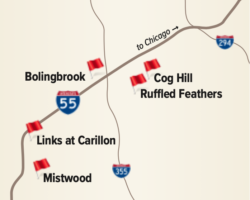 A few miles west of Cog Hill and Ruffled Feathers, on the other side of I-55, is Bolingbrook Golf Club. Located in the village of the same name (naturally), Bolingbrook is a pretty and long layout that was designed by Arthur Hills and Steve Forrest and opened in 2002. From the air, Bolingbrook looks as flat as the lush farmland that surrounds it. It isn’t and semi-blind shots are not uncommon, which can be disconcerting for first- time visitors. Part of the reason comes from the numerous forced-carry tee shots and approaches over ponds, lakes and patches of native grasses.
A few miles west of Cog Hill and Ruffled Feathers, on the other side of I-55, is Bolingbrook Golf Club. Located in the village of the same name (naturally), Bolingbrook is a pretty and long layout that was designed by Arthur Hills and Steve Forrest and opened in 2002. From the air, Bolingbrook looks as flat as the lush farmland that surrounds it. It isn’t and semi-blind shots are not uncommon, which can be disconcerting for first- time visitors. Part of the reason comes from the numerous forced-carry tee shots and approaches over ponds, lakes and patches of native grasses.
The holes are wide, however, and what trees there are seem well off to the sides. The fairways are wide, too, but often winding like a snake which can make them harder to hit. Well-placed fairway and greenside bunkers, as well as a few fall-offs around the putting surfaces, complete this pretty picture and provide additional challenge to both average and more skillful players. “Risk/ reward” is big at Bolingbrook. Many of the ideal landing areas are clearly in view but so are the many hazards that edge into those spots from one side or the other. Thankfully a safer but longer route is always there for the taking. Well … perhaps not at the 15th, a short but scary par 3 over water to an island green. Like a Venus flytrap, it’s very attractive but very dangerous, too. From the back tees, Bolingbrook measures just over 7,100 yards. Fortunately, four other tees are available, the shortest coming in at just under 5,000 yards.
A few miles southwest of Bolingbrook, back across I-55 once again, there’s another quaint village to visit and another fun course to play. Located outside of the Village of Plainfield, The Links at Carillon is a 27-hole facility that Golf Digest has rated one of the “Best Places to Play.” The three 9s here — the Red, White and Blue — are all the work of architect Greg Martin. The Blue and White opened in 1990, the Red was built in 1996.
Once you see this very attractive facility — much of it weaving through a residential community — you may wonder why they didn’t name it The Lakes at Carillon. That’s because, brother, there’s a lot of water to contend with and keep you on your toes.
At many of the holes here, the farther back you play them the tighter the tee shot. If thick bushes or deep bunkers aren’t waiting to gobble up wayward golf balls, there’s a road or a river also ready to ruin your score. And even though it’s true the greens at The Links at Carillon are big, they’re also well guarded. So while you’re on your toes, be sure to tip-toe around the greenside trouble as well. Of the three 9-hole combinations — each offering five tees — the Blue/Red measures between 5,045 and 6,574 yards and the White/Blue measures between 5,167 and 6,631 yards. The Red/White combo is the longest, measuring between 5,344 and 6,899 yards. Sorry to keep harping on this, but choosing the right markers is important here. If you do, the chances are good you’ll have a fun time at a facility that’s known for almost always being in excellent condition.
Playing all these fine courses — no matter if it’s spring, summer or fall — can make a golfer thirsty for more. Well … for a wee dram of something right out of Scotland, be sure to belly up to the first tee at Mistwood Golf Club before your trip along I-55 is over. Located a few miles south of The Links at Carillon, outside of the (no surprise) Village of Romeoville, Mistwood is a gorgeous layout originally designed by architect Raymond Hearn in the early 2000s. A dozen years later, the facility’s new owner hired Mr. Hearn to renovate Mistwood and make it even better. That he did. Golf Magazine thought so, too, honoring the course with its “Renovation of the Year” award when all of the work was complete. Today, Mistwood offers five sets of tees between 5,332 and 7,005 yards. For those golfers that have never played in Scotland or Ireland (I have and it’s a treat), you’re in for an Americanized version. The golf is different, the scenery is spectacular, and the experience is what you make of it. What’s different about this very pretty course and so many across the Atlantic, is that you don’t have the same opportunities to play “along the ground.” (In Ireland once, I used my putter from 50 yards out and it was the right choice!) The main body of water here, the aptly named “Loch” St. James, is ever-present — whether in the form of a creek, pond or the loch itself, and the only choice is to play over. Also common at Mistwood are tall patches of fescue and bunkers of all kinds and sizes — large and small, both sand and grass. In addition, there are 20 revetted bunkers, hazards with tall front walls made of sod bricks. Once in there, you’ll probably have two choices: sideways or backwards. My advice is: don’t go in there. My other advice is: do make an effort to tee it up at Mistwood Golf Club.
As I’ve said so many times, picking the right tees is a good idea. Maybe the best idea, however, is to pick I-55 when you’re looking for great golf southwest of the Windy City.
Follow the Food
At the beginning of your Chicago-area golf trip, you’d be advised to do more than sample the fantastic food available around town. And it all starts with Lou Malnati’s delicious deep-dish pizza.
Since the 1940s, Malnati’s has been famous for making its pizza “backwards.” Unlike most pizza, Malnati’s “toppings” are first placed on the crust, then the cheese and sauce are spread out on top. With almost 60 locations in the Chicago area, Malnati’s is a must visit.
![]() For something a bit fancier, head to the hidden gem called the Topaz Cafe (topazcafe.com), just off I-55 in Burr Ridge. The Topaz offers a fine contemporary American menu specializing in steaks, chops and seafood. Take your pick of the outdoor patio, two indoor dining rooms, lounge, or even the VIP room for the high rollers. It’s a great place to spend your Nassau winnings.
For something a bit fancier, head to the hidden gem called the Topaz Cafe (topazcafe.com), just off I-55 in Burr Ridge. The Topaz offers a fine contemporary American menu specializing in steaks, chops and seafood. Take your pick of the outdoor patio, two indoor dining rooms, lounge, or even the VIP room for the high rollers. It’s a great place to spend your Nassau winnings.
Toward the end of your trip, make sure to chow down on the wide variety of chicken dishes that are available at White Fence Farm restaurant in Romeoville. First established in the early 1920s, back when I-55 was still called U.S. 66, White Fence Farm is as famous for its chicken as Malnati’s is for its pizza. Owned and operated by the Hastert family since 1954, the original location in Romeoville offers indoor dining for groups of all sizes. Too busy playing golf to sit down for a meal? White Fence Farm also has four carry-out locations – including Plainfield.
For great golf and great food, you can’t beat I-55.

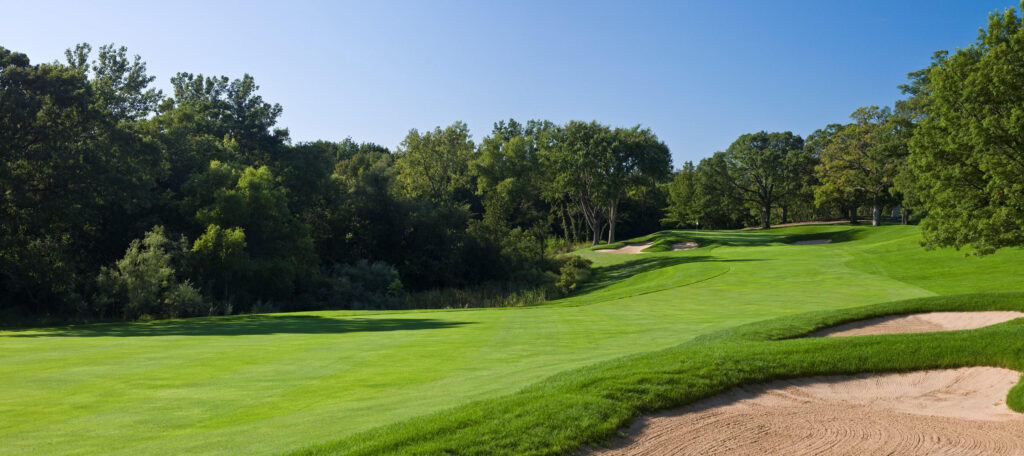
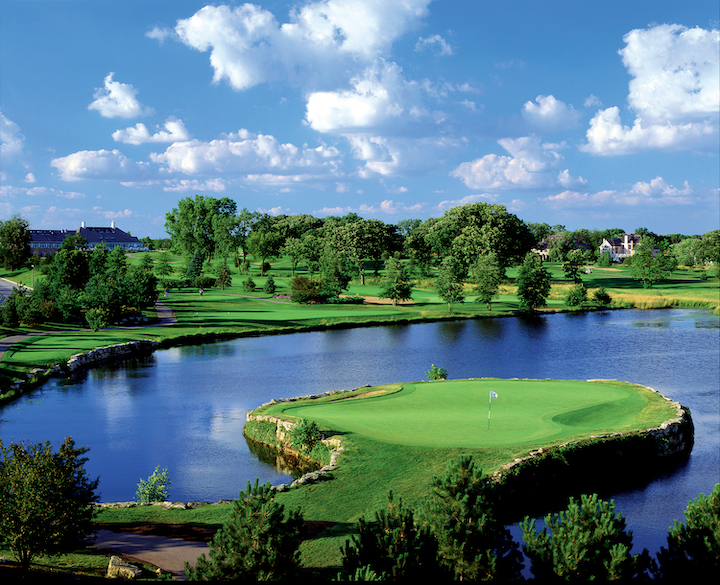
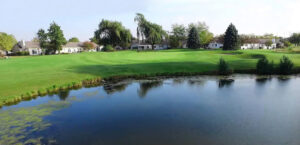
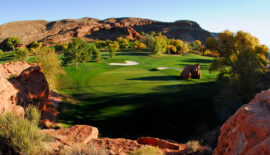 ';
';
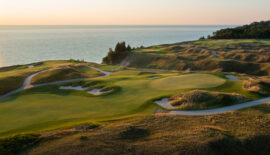 ';
';
 ';
';
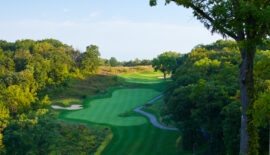 ';
';